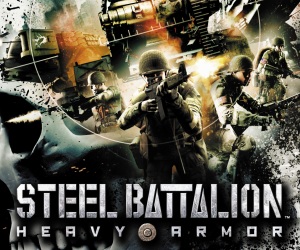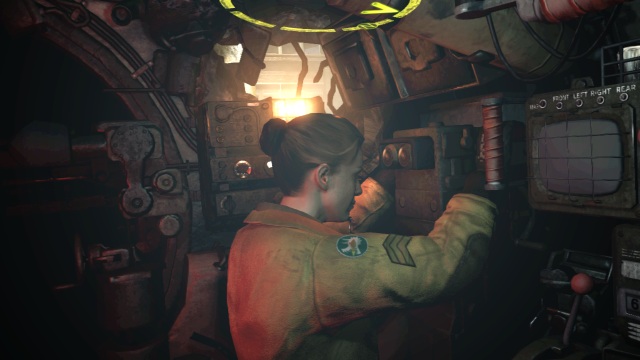Steel Battalion: Heavy Armor Review

Game: Steel Battalion: Heavy Armor
Developer: From Software
Publisher: Capcom
Available on: Xbox 360 with Kinect only
Way back before giant game peripherals like living room-filling Rock Band instrument sets became common features in games-playing households, there were several bonkers add-ons produced to enhance a variety of different titles, many of which you may not have heard of, let alone played around with. Crazy Japanese drumming series Taiko No Tatsujin made Far Eastern ceremonial drumming from the comfort of your home a reality with its bongo controller. Trippy shooter Rez had the curious Trance Vibrator, which pulsed in time to the in-game music and undoubtedly ended up living a double life as something far more salubrious.
But the most insane gaming controller to emerge in the last decade was quite easily the humungous twin-sticked panel of flashing, button pressy machinery that shipped with Capcom’s Steel Battallion. Deciding that the likes of MechAssault and Armored Core were clearly not delivering on their promise of offering the definitive vicarious bipedal mech experience, Capcom’s game was unique, exciting and immersive, giving the player control over pretty much every aspect of controlling their assault vehicle, from loading the weapons right down to operating the windscreen wipers. It may have looked ridiculous, but the controller -with its foot pedals, levers and dials – worked a treat and is now considered something of a collector’s item. Above all, the game – and its 2004 sequel – was a winner in the gameplay stakes, easily one of finest mech titles of its era, and was undoubtedly enhanced by the control scheme even if you did have to shell out well in excess of a ton to pick it up.

Despite the mech simulator being a niche genre that seldom troubles the charts in the West, Capcom apparently broke even financially with this foray into mental controller land and the game is remembered fondly by those who played it. In these harsh financial times, it is unlikely that a similarly proportioned controller would sell as well as it did back in the day. But there are other ways of immersing yourself in a game without having to own half the innards of a heavily armoured futuristic kill-bot. Which is why Capcom have given the reigns of their decade-old mech concern to From Software and asked them to produce a similarly satisfying experience, harnessing the motion sensor powers of Xbox Kinect. From Software don’t usually mess around when it comes to delivering hard core titles, they were the sick minds behind the ball-achingly difficult Dark Souls, and they have recent, quality form in the mech genre, having dropped the excellent Armored Core V earlier this year. Kinect has been criticised for not delivering on its promise of worthy, motion controlled games. This is in part due to its inherent unreliability – something that plagues many motion controller devices – but also due to a preference within the industry to saturate the market with mini-game compilations, sports titles or dance-offs. Can Heavy Armor stand proud as being the first truly full-on, grown up Kinect corker?
STORY: The year is 2048 and as revealed by a bleak opening movie, the world has fully gone to shit. Somewhere down the line, some kind of freaky bacteria has destroyed all microchips and processors, plunging humanity into a future without computers. It would appear that a newer, altogether more nasty and genocidal version of the United Nations has taken control. It isn’t explicitly mentioned, but this new regime, nicknamed Uncle by the American protagonists of the game, appear to be from China. Controversial much?

You play the part of Winfield Powers, a splendidly named tank pilot, who as is often the case in these wartime scenarios, has a mysterious past. It is your job to help take control of one of the retro-futuristic Vertical Tanks and engage in a number of crushingly hard sorties against the ominous Uncle forces. Heavy Armor takes you to a number of locations around the globe, from a D-Day style landing on the coastline of New York to the blazing hot deserts of Africa.
You do this with your three co-pilots, each of whom have their own individual personalities and foibles and can be interacted with during the course of the game. As you progress, more information about Powers and his team is revealed, and while most of the plotlines are cornball war movie clichés, you will find yourself becoming emotionally attached to the whole shebang. You will also want to beat the crap out of them at times, but more of that later.
GRAPHICS: Visually, Heavy Armor is perfectly serviceable. In fact, at times it looks great. The opening mission, which resembles a kind of future-war D-Day landing scenario, is stunning. Many of the environments look excellent and there are some superb explosions. Sadly, things do become a little boring and repetitive, something that becomes particularly noticeable in that you will find yourself having to re-do missions over and over again. The game hub and the co-pilots in it, all look excellent, though some of the lip-syncing is a bit dodgy, the character models look ace.

SOUND: The first thing you hear when you start a new campaign is the word “fuck”. There is a ton of swearing in this game, something that some will find jarring and uneccessary and others will enjoy. Personally speaking, I imagine that if I was cooped up inside the claustrophobic interior of an antiquated tank with three American squaddies, I would probably swear a lot too. The voice acting is cheesy, action-movie fare. They even pinch lines from action movies; at one point the brilliant “You old son of a bitch!” uber-macho greeting between Arnie and Carl Weathers from 80s classic Predator is lifted, wholesale. I am in no way complaining about this.
GAMEPLAY: On paper, the third Steel Battalion title sounds like the most awesome thing ever. A straight up, First Person mech actioner, which gives you an unrivalled sense of control, in a series of nails-hard missions. Kinect places you inside the cockpit, where you for the most part remain seated and use hand motions to operate the various dials, buttons, levers and panels. You can stand up and look out of the hatch, where raising your hand to your brow like the male models in the Freemans catalogue will activate your binoculars so you can scope out your targets. Interaction with your co-pilots can involve giving them six of the best if they play up, and you can also batter any intruders if they somehow manage to work their way into your craft. All of this and more, is achieved using a combination of the standard Xbox controller and the motion sensor capabilities of the Kinect device.

Moving your VT and firing its weapons is done using the controller, with everything else operated using hand gestures. A tutorial explains how to operate the many controls inside the tank. In theory, it should be easier to pick up than having to master the original Steel Battalion controller, which had something like fifty buttons. There are gun turrets, shutters, navigational computers, a thrust lever and even a self destruct button amongst other things, all situated in different areas of the hub. The problem is, the Kinect is simply too haphazard with its accuracy and more often than not you will find yourself grabbing, pressing or pulling the wrong lever or button, and given the extreme difficulty of the game even before you factor the control scheme into the equation, becomes extremely disheartening, very quickly. Quite simply, there is too much packed into the cockpit, and the Kinect – which works fine when it is required to recognise broader, sweeping gestures – is baffled by the close proximity of the controls and cannot cope with the degree of subtlety required.
This is a terrible shame, because had the controls been accurate, then the imaginative ideas on display make this arguably the best mech shooter I have ever played. Occasionally it does work and for brief interludes you are destroying Uncle targets with aplomb, venting the smoke from your cockpit to avoid suffocation and preventing your wingman from being stabbed to death; it is excellent. But for every burst of gameplay where you hit a sweet spot with the Kinect, you will end up swearing more than your onscreen counterpart as you fail and die yet again.
LONGEVITY: Heavy Armor will last you quite a while, but for the wrong reasons. The game is challenging and there are unlockable co-op missions, skins to customise your vehicle and new weapons to play around with. The reality is, many gamers will want to switch off before the end of the single player campaign, given the frustrating controls which lead to so many accidental deaths.

VERDICT: Unfortunately it is impossible to look beyond the broken controls. I tried everything I could to make the game work better: Sitting on a dining room chair rigidly upright as opposed to sitting on my sofa, to mimic the bolt-upright way Powers would be sat before the console in his VT, recalibrating Kinect to kingdom come, but there were still inaccuracies that led to unavoidable death. Switching between a controller and hand movements and indeed combining the two is just too much to ask.
Could Capcom patch the game and remove the Kinect controls? I suppose so, but then I cannot fathom how the many dials and panels and levers could be intuitively mapped to the buttons on an Xbox controller alone, without compromising the real-time panic that the game is so obviously meant to portray. Ironically I felt myself longing for the dreadnaught-sized controller I used in 2002. I cannot bring myself to give Steel Battalion: Heavy Armor too much of a beasting, because when it works, it gave me a tantalising glimpse of what would might have been. It’s therefore a dreadful shame that an idea so superb has ended up this way.





